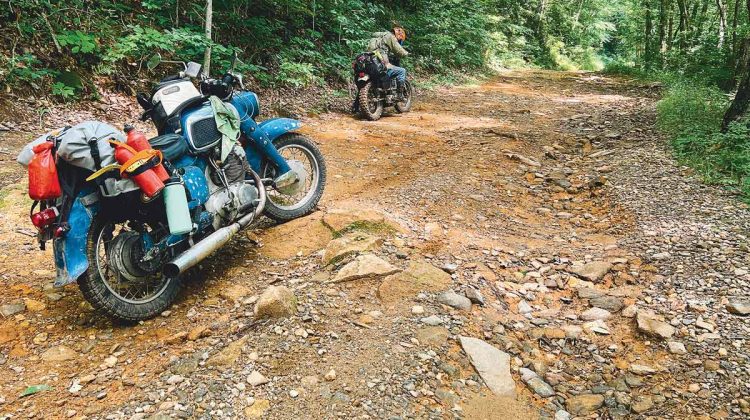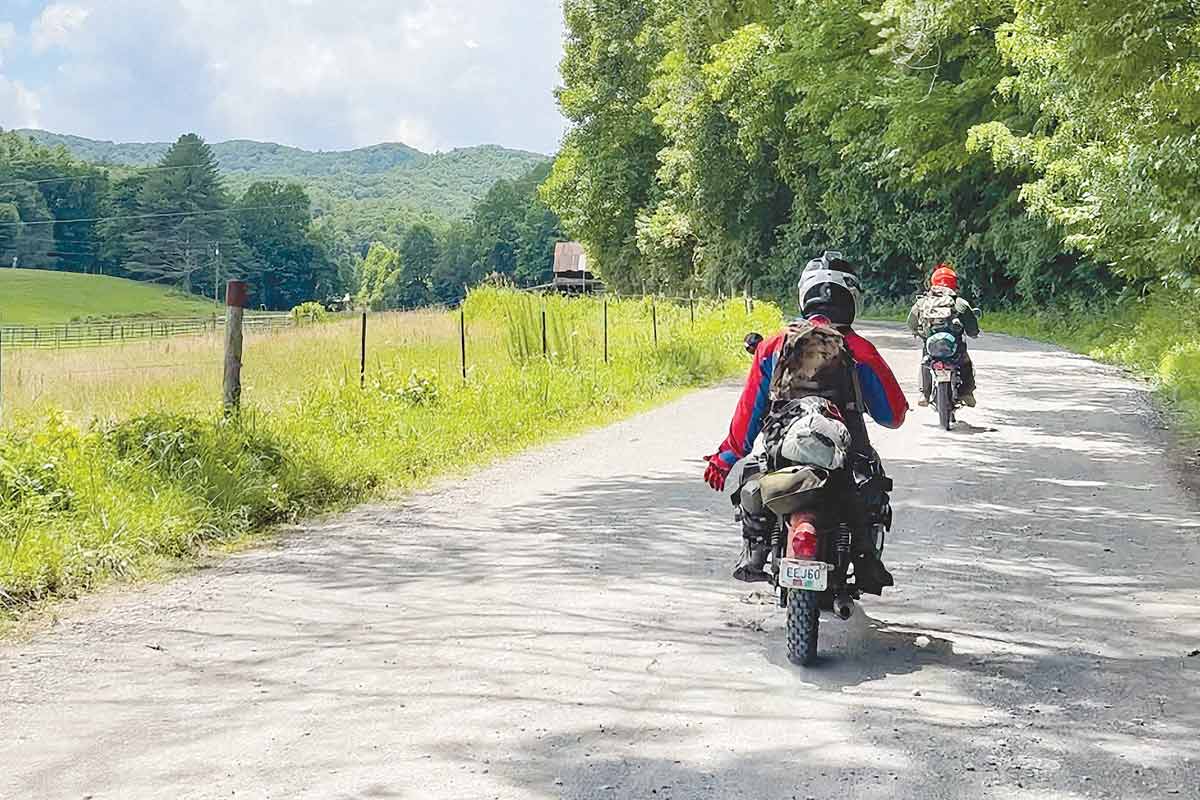
I’ve always wanted a 1960s Honda Dream 305. I love vintage Hondas. There are about 15 in my garage right now: Trail 90s, CB100s, SL350s, XL500s, CB750s and even an early ’80s GoldWing. The one thing that’s always been missing — a Honda Dream.
Aesthetically, there’s nothing quite like them. At the time of their introduction, they were somewhat futuristic while already having a nostalgic look, making them truly timeless. The chrome toaster tank, the variety of colors — these bikes were designed for the nicest people. It was a heavy touring bike at the time. It was comfortable, offered a smooth, soft ride, and boasted more than 100 mpg and nearly 100 mph. It was an instant classic and became one of Honda’s most iconic machines.
I would occasionally browse the internet looking for one for sale, but I would usually be put off by the price or condition. I was window shopping, just sort of waiting to find the right one. Do you believe in manifestation? What about finding a good reason to buy a motorcycle? Any reason could be a good reason ….
I participate in an event called the Vintage 1000, an event that is a call back to the long-gone days of vintage enduros and is period correct in every sense. Bikes must be built before 1981 and have no modern modifications. It spans five days and 1,000 miles through the mountains and backroads of Tennessee, Georgia, and North Carolina — all on vintage motorcycles.
The intention is to pack in as much off-road riding as possible as the route twists through the Appalachian Mountains, taking you through some of the most beautiful and exciting riding in the Southeast. The Vintage 1000 really puts to test the notion that, “They don’t make ‘em like they used to.” I’ve joined the ride for about eight of its 10 years. If I’m not riding, I’ll be driving one of the chase trucks with a trailer, rescuing riders from the woods.
In the past decade, countless bikes have failed to finish the ride. The elements, amount of preparedness, mechanical issues, engine seizures, even broken bones — anything and everything can be a reason for not finishing. A majority of the riders and bikes typically complete the adventure, with the success rate gradually increasing as the years go on. The idea behind the rule for pre-1981 motorcycles stemmed from a limiting factor in terms of technology. The goal was to eliminate bikes with a mono-shock or any sort of water or oil cooling.
When you have something fun and challenging, why not make it harder? Which in effect makes it more fun, right? Or at least that’s what I’m assuming rider founder Adam Sheard’s thought process was behind the decision to introduce the “Pre-1968 Vintage 500.” This made the perfect excuse to buy a Honda Dream. One of the main reasons for the cutback over a decade was to eliminate a certain subset of bikes from competition. Any guesses? In addition to easily eliminating the uber capable XL and XT500s, Adam no longer wanted any Honda twins on the ride: CB/CL/SL350s. Even CX500s were known to participate. Nothing can kill a Honda twin. Well, this ride has killed a few, but it takes a lot!
Honda twins have been one of the most popular ride choices for the Vintage 1000. Behind that would be the early enduro bikes of the late ’70s. You do get a variety of bikes, though. Plenty of heavy road-oriented BMWs, even a ’70s Harley ironhead, has done it. There’s been three different two-stroke Pentons: 175cc, 125cc and 100cc. There’s always a handful of British bikes.
You get fewer choices of capable motorcycles when you go back in time a decade, but in my opinion, the bikes get a lot cooler. And you still get some Honda twins. Like I said, the perfect excuse to buy a 1965 Honda Dream 305.
While a Honda CL77 Scrambler may have been the more appropriate choice, there’s something romantic about riding an inappropriate bike on one of these rides. It’s more visceral, more taxing and more physical. It hurts more. Heck, riding any 1960s motorcycle 500 miles through the mountains is a challenge, but now imagine doing it on a 420-pound (with luggage), pressed steel, 60-year-old tractor that feels like it’s going to fall apart at any moment. Adventure. Pure adventure, that’s what it feels like.
My usual weapons of choice are either a 1981 Honda XL500 or 1972 Honda SL350, but now it was time to find a Dream. I have a rule when buying bikes, $1 per cc. Kind of a hard rule to follow. Imagine a Trail 70 for $70. That rule usually means the condition of the bike maybe isn’t immaculate or could use some wrenching, but if it’s a Honda, all it should need is some fresh gas and a new battery.
Finding the right bike
I put out feelers to my motorcycle friends and soon had some leads. Andrew Duthie, a good friend of mine and the wrench behind Nashville Motorcycle Repair, just so happened to have an interesting candidate.
“Yeah, I’ve got one in the back of the shop I think,” he told me. “It’s a 1965. I got it running nearly eight years ago for someone, but I think it just ended up being abandoned. It should mostly still be there. I haven’t looked at it since. How about $500?”
While that was more than my $1-per-cc rule, it felt fair enough. Andrew is a trusted source, so if he says he got it running a while ago, hopefully it shouldn’t take much.
Fast forward a few weeks, I’ve got the Dream on my lift and am about to go through the usual suspects. It was dry stored, motor had plenty of compression, valves were in spec. I put some oil in, a fresh battery, new gas. I went through the wiring, found a few connections that could be cleaned up. After a few hours I had everything buttoned up, leaving only one thing left to do — kick it! It’s a Honda, and if you’ve ever kicked a Honda Dream, you know how incredibly easy they turn over and start, and that’s exactly what happened!
It awoke from its eight-year slumber with just one go, rumbling and shaking every tool on my lift. I let it idle and stared with pleasure and excitement. I cut the motor and decided to try the electric start. I pushed the button, the starter motor made that classic “catching/grinding” noise as it turned and spun, and boom — it fired! Nothing left to do but ride it.
You can quickly tell if there’s something funky going on inside a motor. Sound is usually a giveaway, but that paired with weird shifting and some noticeable clunking is also a tell. And unfortunately, that is what I discovered on the maiden voyage of the Dream. While it did run, there definitely was something going on. First and second gear were dodgy, but after getting into third and getting up to speed, the issue seemed to subside, and the bike ran smoothly. Not wanting to destroy anything further, I gave up riding for research.
I searched the forums and even posted a video of the bike making the noise in a Facebook group to see if anyone had any insight. That’s when the legendary Bill Silver chimed in with the thought that it was probably the low gear bushing between first and second gear in the transmission. Silver, sometimes known as “Mr. Honda,” is literally keeping the Dream alive. He is the go-to source for most everything Honda 305. He runs dedicated websites, sources and sells new parts, he even wrote an incredibly detailed engine repair guide that would soon guide me through the process.
He was right about the diagnosis. A simple description and sound were all it took. That meant rebuilding the transmission. The good news about these motors is that they are “relatively” simple, and my only issue was isolated to the transmission. I’d only have to open the bottom end. You can repair the transmission while leaving the top end intact, some great engineering to make these motors easy to work on. So out with the motor, flip it upside down, remove the 14-or-so bolts holding the bottom case on and pop it open. Viola! A transmission filled with gears and many moving pieces.
I started searching for some answers and quickly noticed some missing teeth on first and second gears. I disassembled the pieces further, and sure enough, the low gear bushing was worn and way out of spec. Apparently, this is one of the most common issues with the Honda Dream.
Did I mention the Dream I bought happened to come with A LOT of spare parts. Seems like they always do. It had nearly a whole engine worth of internals, a spare wheel, extra suspension, and other miscellaneous body parts. Would you believe it had nearly everything I needed for the repair? Replacement first and second gears, even another low gear bushing, though I ordered a newly made one just to be safe.
Over the course of a day, I had the transmission repaired with new gears and bushings, replaced some seals, and had it back together. I put the motor back in the frame and was ready to give it another test ride. Take 2: first kick and I was off, through all the gears much more smoothly. Mission success! I spent the next few weeks doing some final preparations to the bike to get it as ready as possible to ride 500 miles through the Blue Ridge Mountains. What preparations? Well, knobby tires and that was about it. There’s not much else you can do. I mounted my Giant Loop brand luggage to the bike, packed it full of camping gear, clothes and spares. Now I was ready for an adventure.
The Pre-1968 Vintage 500 takes place for three days, with approximately 150 miles a day across some of the best adventure riding in the Southeast, all on motorcycles make before Nixon was president. The goal is the scenic route, with as much off-road miles as possible. Gravel, dirt, mud, river crossings, you name it. No GPS allowed. Roll-chart navigation and overview maps only. You better hope your odometer is accurate as you count your miles and watch for misleading turns in the woods as you try and make it to camp each night with as few issues as possible. There’s always issues.
There was a great variety of bikes: two 1965 Honda Dream 305s and two 1966 Honda CL77 305 scramblers. The smallest bike on the ride was a 120cc two-stroke 1967 Kawasaki C2SS “Roadrunner” followed by another two-stroke 1964 Yamaha YDS3 250cc. There was a spaghetti Harley, a 1965 Aermacchi Sprint 250cc H. The rest were the British crowd, handful of BSAs and Triumphs. It was a great mix of riders, too. Folks came from far and wide to participate. For some it was their first time doing something like this, others had anywhere from three-to-10 previous trips.
First day, and there’s issues
Day 1. We all left early that morning from Chattanooga and headed northwest with our sights set on Robbinsville, North Carolina. The day was soon filled with open backroads as we got out of town. We weren’t far from dirt either, we could see the mountains in the distance beckoning us. Our pace thus far had been alright. Honestly, I had been having the most issues out of anyone in our group. Nothing major, I had just been shaking about every bolt loose on the bike, having to stop occasionally to tighten and adjust things. We met gravel. I quickly learned this suspension wasn’t really meant for this type of riding, but I knew that going in.
Halfway through the afternoon we made it to Witt Road, notorious for its water crossings. Some deep, some technical, all incredibly fun. Ever seen a Honda Dreaming its way through three feet of water? There’s a first for everything. A few bikes got wet and needed some time to dry out the plugs and air filters, but we kept trucking along. In classic summer fashion, rain was soon on the way. So was night. We were still far from camp. While it was maybe only 30 miles, that translated to another hour-and-a-half in the woods. Right then is when my bike gave out — at 7:30 p.m. just as the rain started. Believe it or not, I was stuck right in front of a waterfall, so that was nice.
I had power. There was gas in the carb, but very weak spark. The more I kicked it, the weaker the lights got. Bump starting wouldn’t do anything either. It was only getting darker, and the rain was picking up. Nothing super obvious was jumping out at me. Coincidentally, the support truck just so happened to be further down the road rescuing another bike, so I called for a tow to get myself back to camp.
It was 11 p.m. and storming when we all arrived back at camp. I quickly removed my bike from the trailer, unpacked my camping gear, set up my tent and then got busy working on the Dream. With a bit more time and concentration — yet still more rain — I was luckily able to identify the issue. In addition to shaking every bolt loose, it looked like I had also shaken some wires loose. Mainly the ones that connect the charging system. It was clearly something from the stator, which would explain my issues: the battery had been draining while running. A simple enough fix. I reconnect everything, put it on a charger overnight and hope for the best the next day.
Day 2: Another day, another great adventure
We woke to continuing rain from the previous night, everything we had was soaked. Like I said, more “adventure.” We spent some morning time doing some minor repairs before hitting the road for another 150-mile day. After a late start, we hit the twisty pavement of the Cherohala Skyway. The Dream was sewing along at 50 mph no problem, this was a touring bike after all.
Dirt soon followed as we traveled through Andrews, North Carolina, and headed east into the Nantahala National Forest. The mountain passes were grand. The views were amazing. We were making decent time, though I’d get some backfiring every once and a while, and the bike would chug along momentarily. We’d stop for something, and I’d once over the bike looking for any obvious problems. I couldn’t find anything. “Ride it until it don’t ride,” so we continued onward.
Time and miles passed, and the problem seemed to become more frequent. The bike was acting as if it were running out of gas, so I hopped off and dug further. A clogged gas cap that wouldn’t vent and a dirty petcock were my conclusions. The flow of gas out of the tank was very limited. I’d blow air through the fuel lines, crack the gas cap, and that would get it back flowing. While I was able to come up with temporary fixes, the problem just kept persisting. My preparations included cleaning out the gas tank, but the gas cap and petcock were original, so it made sense some stuff could be floating around and getting stuck. All this meant was I’d be in for some wrenching at camp tonight.
The sun was fading and our destination for the night was still a couple hours away. I made the responsible decision of calling in for a tow the remaining 40 miles. The vintage Land Cruiser soon picked me up as we followed my group the last of the way. In classic nightly routine, I removed my bike from the trailer and got to wrenching. At least it wasn’t raining.
I proceeded to take the tank off and siphoned out the gas. I cleared out the gas cap of any mess, I removed the petcock and disassembled it, cleaned that, too. There were signs of gunk and dirt throughout, so I was hoping that this would alleviate any further issues. We’d find out soon enough the next morning.
Day 3: The final day is always bittersweet
My excitement from wanting to continue the adventure mixed with my exhaustion and a will to sleep in my own bed. We woke early to head back to Chattanooga and finish up the remaining 500 miles. You’d think the last day would be easy? Up until this point, everyone would have said that the first day was the most difficult. If only we knew what we were in for…

Our route today was west through the Chattahoochee-Oconee National Forest. If you’ve ever ridden through these sections of north Georgia, you know the variety of terrain encountered. Remember, I’m on a 1965 Honda Dream. I’m passing folks on brand new Yamaha Teneres and KTMs, getting the strangest looks and being asked if were lost. While we maybe didn’t have any clue where we were, we definitely were not lost. We kept riding, racking up miles and following our roll chart. Pavement turned to rocky gravel, which eventually turned to puddles of mud from the previous rains. Bikes were slipping, riders spilling, luggage was getting shaken off, but we were all having the times of our lives.
As we approached the middle of the day, almost right on cue, the afternoon storm clouds rolled in. We were deep in the woods somewhere outside of Cherry Log when thunder roared, and rain fell. We had stopped to put rain gear on, but after a certain point there’s no avoiding getting soaked. We were still pushing onward. I would just have to wipe my goggles dry every few seconds. Luckily, I did just in time to notice the huge, downed tree blocking the road ahead.
We stopped to assess the situation. We had two options — over or under. The rider of the small, 125cc Suzuki two-stroke elected for over. He made it look easy. All of us on heavy bikes had to go under, which took four hands and a good bit of leaning to make it. Five minutes later, we were all on the other side and on our way. The rain eventually passed. The clouds parted, and the sun emerged. We were getting closer to the finish line, but not without one last obstacle.
We’ve nicknamed this section the “Georgia Red Clay Hill of Death,” or something like that. It’s a mile-long section of Georgia red clay that is entirely uphill, with three specific climbs. When would be the worst time to try and ride up something like this? Immediately after a rainstorm. What would be the most inappropriate bikes you could ride up this hill? Sixty-year-old street bikes weighed down with luggage and barely any knobs on the tires. How do you do it? Momentum and the right line. Don’t stop. Look where you want to go. When in doubt, throttle out.
I estimated that one mile took us about an hour to cross. One or two folks did it successfully without issue, while the rest of us had more fun. I was slipping and sliding on the Dream, I ended up in ditches and ruts, dropped the bike at least twice and laughed the whole time. It took two people pushing me up the final steep section for the bike to have enough traction and momentum to make it up. But we did it! We stopped for lunch, and all breathed a sigh of relief.
It was the middle of the day. The sun was finally warming everything up and drying us off. We were nearly home free and had less than 80 miles of backroads to get us to Chattanooga. The Dream was running much better than the previous day, everyone in our group was doing well. We continued scrolling past directions on the roll chart. Trees turned into buildings, dirt into pavement and we eventually made it into town before sunset.
What an adventure. There really is no other way to put it, there really is nothing out there quite like this. Old motorcycles and the open road, give it a try.
Our bikes were covered in mud and oil — and so were we. We were battered, road-worn, but fulfilled. There was only one bike that had to be towed back into town, which statically is very impressive on these rides. Nothing left to do but relax and celebrate. We all gathered around for dinner that evening to reminisce about the past three days, and all of the perils and triumphs. We shared our exhaustion, but also our excitement for the next time we’d all get together and do it again. y


